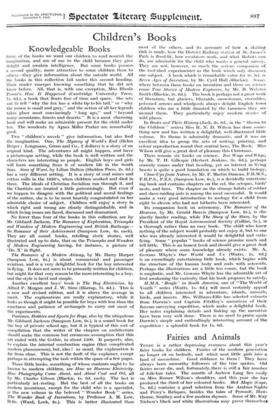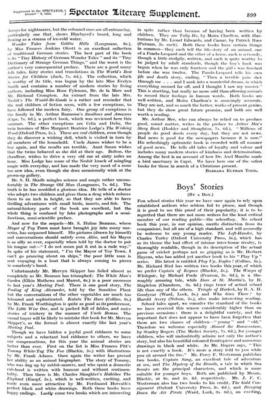Fairies and Animals
THERE is a rather depressing evenness about this year's fairy books for children. Fairies of the modern generation no longer sit on bedrolls, and whisk neat little girls into a land of moonshine. Good riddance to them They have always been unworthy followers of the true sprites. Old fairies never die, and, fortunately, there is still a fair number of folk-lore tales. The mantle of Andrew Lang lies cosily on Miss Romer Wilson's shoulders, and this year she has produced the third of her coloured books. Red Magic (Cape, 7s. 6d.) contains a good selection from the Arabian Nights and Percy's Reliques, besides the tales of Perrault, Haw- thorne, Southey and a few modern rhymes. Some of Mr. Kay Nielson's black and white illustrations may prove themselves
decoys for nightmares, but the coloured ones are all entrancing, particularly,_ one . that shows Bluebeard's beard, long and flowing as a stream of ice-cold water.
Wonder Tales from Goblin Hills (Longmans, 6s.), by Miss Frances Jenkins Olcott is an excellent collection of traditional German stories. The best part of the book is its "Tiny History of German Wonder Tales " and its "Tiny Dictionary of Strange German Things," and the worst is the author's very consequential preface. There are a good many folk tales, fairy stories and translations in The World's Best Stories for Children (Jack, 7s. 6d.). The collection, which is worthy of its title, was begun by the late Miss Evelyn Smith and contains a number of modern stories by living authors, including Miss Rose Fyleman, Mr. de In Mare and Mr. Richmal Crompton. An extract from the late Mrs. Nesbit's The Would-Be-Goods is a rather sad reminder that the real children of fiction seem, with a few exceptions, to have followed the modern fairy. One group of exceptions is the family in Mr. Arthur Ransome's Swallows and Amazons (Cape, 7s. 6d.), a perfect book, which was reviewed here this summer. The other exceptions are Celia and Delia, the twin heroines of Miss Margaret Beatrice Lodge's The Wishing Wood (Oxford Press, 5s.). These are real children, even though they, do discover a wishing dell, which is visited in turn by all members of the household. Uncle James wishes to be a boy again, and the results are terrible. Aunt Susan wishes that the twins behaved as she did at their age. Bolton, the chauffeur, wishes to drive a very old car at sixty miles an hour. Miss Lodge has some of the Nesbit knack of mingling magic with everyday, and has made the very most of a none too new idea, even though she does occasionally wink at the grown-up gallery.
Mr. S. H. Skaife mingles science and magic rather uncom- fortably in The Strange Old Man (Longmans, 7s. 6d.). The truth is he has muddled a glorious idea. He tells of a doctor who adopts two children and gives them a drug which reduces them to an inch in height, so that they are able to have thrilling adventures with small birds, insects, and fish. The natural-history parts of the book are excellent, but the whole thing is confused by fake photographs and a semi- facetious, semi-scientific preface.
And now for the sequels—Mr. S. Hulme Beaman, whose Mayor of Toy Town must have brought joy into many nur- series, has surpassed himself. His pictures (drawn by himself) and conversations should satisfy even Alice, and his Mayor is as silly as ever, especially when told by the doctor to put his tongue out—" I do not mean put it Out in a rude way." In spite of his statement, " I'm the Mayor of Toy Town, I can't go prancing about on ships," the poor little man is sent voyaging in a boat that is always coming to pieces in somebody's hand.
Unfortunately Mr. Mervyn Skipper has failed almost as completely as Mr. Beaman has triumphed: The White Man's Garden (Elkin Mathews and Marrot, 6s.) is a poor successor to last year's Meeting Pool. There is one good story, The Fooling of King Alexander, told by the Sensitive Plant but the conversations of the other vegetables are much too laboured and sophisticated. Kalulu The Hare (Collins, Gs.) by Mr. Frank Worthington is quite as good as its predecessor, The Little Wise One, and is packed full of fables, and naive stories of trickery in the manner of Uncle Remus. The casual buyer will be likely to mistake this book for Mr. Mervyn Skipper's, as the format is almost exactly like last year's Meeting Pool.
Though we have bidden a joyful good riddance to some subjects and a reluctant bad riddance to others, we have our compensations, for this year the animal stories are better than ever. First on the list is Miss Frances Pitta Tommy While-Tag The Fox (Blackie, 5s.) with illustrations by Mr. Frank Adams. Once again the writer has proved her ability as an animal biographer. The story of Tommy, who was dug up by rabbit-snarers, and who spent a domestic cub-hood is written with humour and without sentimen- tality. Then there is Mr. Charles Slaughter's Halitibee The Elephant (Knopf, 5s.), which is well-written, exciting, and made even more attractive by Mr. Ferdinand Horvath's Perfect black and white drawings. Both these books have happy endings. Lastly come two books which are interesting
in spite rather than because of having been written by children. They are Tally Ho, by Moira Charlton, with illus- trations by Mr. Lionel Edwards, and Caesar, by Patrick Russ (Putnam, 5s. each). Both. these books have certain things in common—they each tell the life-story of an animal, one of a Panda-Leopard and the other of a horse, each is seriously, though a little stodgily, written, and each is quite worthy to be judged by adult standards, though the boy's book was begun when he was only fourteen and the girl's was finished before she was twelve. The Panda-Leopard tells his own life and death story, ending, " Then a terrible pain shot through me - . . and I sank into a wonderful dream, in which everything seemed far off, and I thought I saw my master." This is startling, but really no more odd than allowing animals to record their feelings in human words. Both lamks are well written, and Moira Charlton's is amazingly accurate. They are not, and so much the better, works of present genius, but they do show great future promise, and both are well worth a reading.
Mr. Arthur Mee, who can always be relied on to produce good, sound matter, writes in the preface to Arthur Mee's Story Book (Hodder and Stoughton, 7s. 6d.), " llfillions of people do good deeds every day, but they are not news. Bad news is good for the newspapers because it is rare." His refreshingly optimistic book is crowded with all manner of good news. He tells old tales of loyalty and valour and includes many modern stories of kindness and determination. Among the best is an account of how Dr. Axel Munthe made a bird sanctuary in Capri. We have here one of the safest books for those in search of a Christmas present.
BARBARA EUPLIAN TODD.



























































 Previous page
Previous page